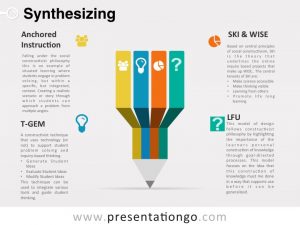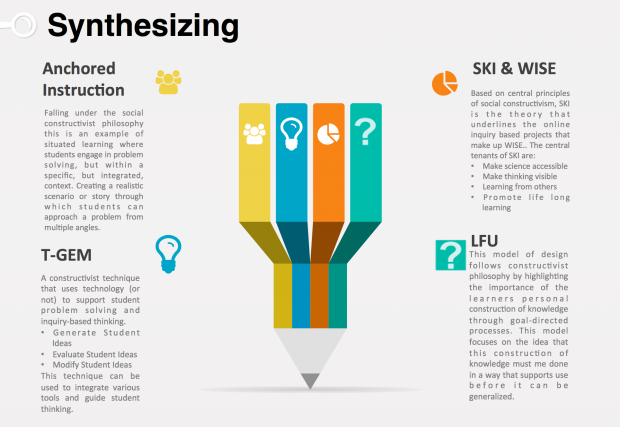
The image above doesn’t view well. To view download a PDF of Synthesizing STEM.
Looking at each of these techniques, design models, frameworks and strategies together I noticed that each were complementary to each other and could be used together in the design and development of a rich, technology enhanced, learning environment. I would almost argue that a well designed module/lesson/course would include all of these simultaneously. There is a lot of overlap across each of these components, mostly around constructivist philosophy, problem solving framework and guided inquiry that the areas where you see differences really complements the rest of the components. At the end the final product is certainly more than the sum of its parts.
In my design of Assignment 2, I employ each of these components in some form across my lesson, from building a case study that creates a situated learning context to having students work through the GEM technique to reframe their thinking after detailed exploration. I think most teachers already do incorporate a lot of these ideas into their teaching, even if they don’t know that they do or they use techniques or models that are nearly interchangeable!

Hi Kari,
I loved your synthesis infographic! You did a great job distilling each theory down to its fundamental foci (plus, I’d never heard of presentationgo.com and now I have another tool in my kit for later use, thanks!). 🙂
I also liked your idea that a well-designed course could include all of these types of constructivist tools, even in the lesson/unit level. This got me thinking about how WISE lessons could be adapted to deliberately incorporate the other TELEs — deliberately using the reflection journal option to guide students through a GEM process, creating a narrative to situate learning or bring in a local context to frame the whole exploration, embedding a PhET simulation and large data sets, maybe even drawing visual representations or comparing GIS data if the content applied. I have to honestly say that I was looking at each TELE individually and hadn’t before thought about how they all could be deliberately synthesized at a lesson, unit, or course-level. Thanks for a great suggestion! I hope you share your Assignment 2 design with us, I’d be interested in seeing how you incorporated things.
Hi Jan!
I sent you an email with a link to my assignment. I would love your feedback!
Hi Kari,
I just noticed the in-course email a couple days ago. I apologize that I wasn’t able to provide feedback in a timely manner. I confess I am not doing a very good job transitioning to the Canvas platform from my familiarity with Connect. 🙁 But your assignment looks very interesting and I look forward to delving into more deeply!
Hello Kari,
Thank you for your synthesis of the TELEs, it definitely helped me to solidify the concepts for me. I would agree that all take a constructivist approach where they provide opportunities to make learning meaningful.
I was recently talking with a colleague about her specific class and how her students have minimal technology skills and the students seem very immature compared to previous grades. They are not excited to use technology, they would rather learn f2f. How would you handle it if there is little motivation to engage with the technology? How would you reframe GEM technique if the use technology is not incorporated?
~Mary
HI Mary,
I would want to dig in a bit deeper to your colleagues situation. Is the classroom a traditional classroom? How has the teacher used tech in the past. How does she support the learners tech skills when introducing a concept that uses tech. What does she define as tech? If the situation is she has been setting up a flipped classroom where students are watching videos before working on homework problems using an online assessment tool THEN coming to class for f2f time that is a lot different from trying to use a tech tool within a f2f classroom. Sorry to be vague! In my experience getting students psyched about using a tech tool means making sure that tool aligns closely with the ultimate goal of the course. so for example if a math class has a lot of skill/drill online assignments with no feedback (just right /wrong answers) but the midterms are all complex word based problems a student would rightly be unexcited to use that tech – they wouldn’t see the value in spending that time. However if the online tool allowed them to practice similar word problems and they were given feedback (not just right/wrong) or hints to help them address their misconceptions then they would see value in that time spent. I think ultimately (and as we have discussed) selection of the tech has to align with purpose and the teacher has to clearly discuss its purpose in instruction (ie sell the tech to the student). From my understanding the GEM technique is a technique that didn’t always have tech supporting it. The T (tech) in the GEM technique is where/how students can locate/access additional materials to help them evaluate and modify their original understanding. Prior to the internet how and where did we ask students to go to find this new information? the library? books? newspapers? Journals? hands on experiments? From my understanding the ‘T’ of the GEM technique is the source of experience or knowledge that student assimilate and accommodate into their initial ideas…or at least that is how I understood it!
Hi Kari
I like the fact that you used an infographic for synthesizing this topic. I have not seen presentationgo.com before and spend a few minutes there. They have a lot a great graphics/templates — thank-you for sharing. There was an ad for Canadian Tire as well…it had items I was looking at a couple of hours ago :).
A good next step might be to share a lesson that “includes all of these simultaneously”.
Christopher
Hi Chris,
Sorry was out of the country for the past week and without internet (or easy to come by internet).
I think my assignment 2 will accomplish a lot of this synthesis – or at least I believe it does! Nearly done so will be happy to share/submit to see what you think!
Cheers,